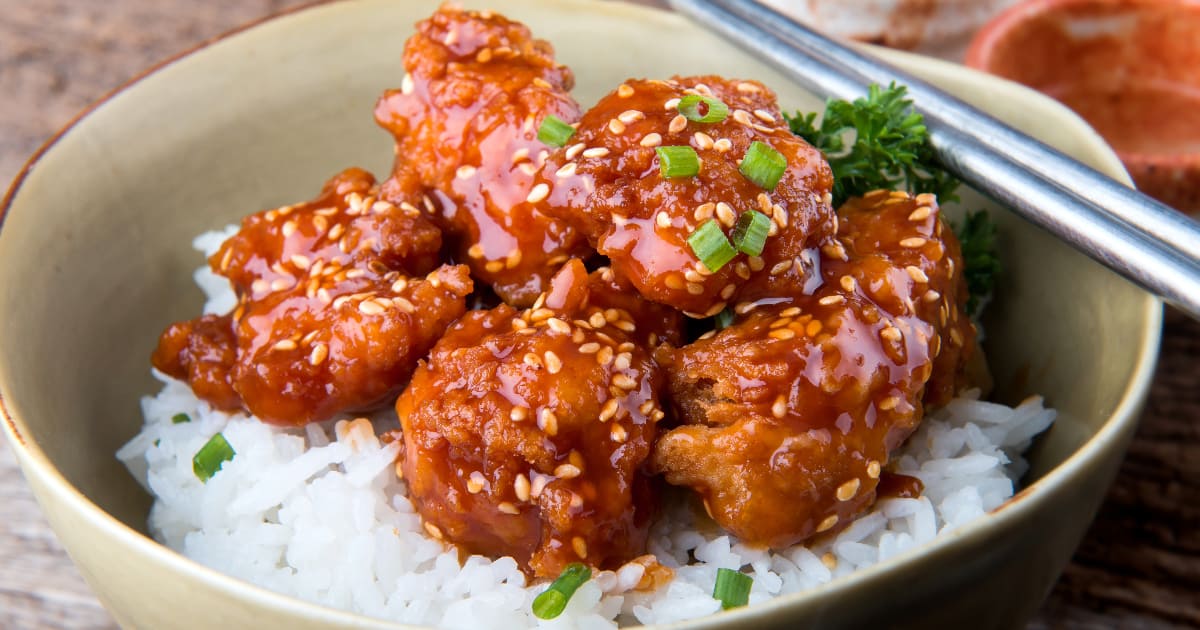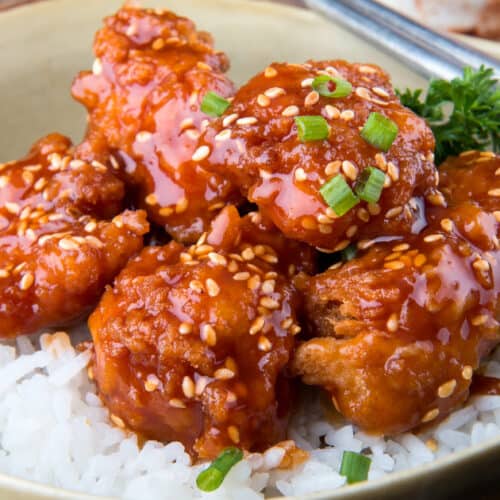Gochujang chicken thighs are a boldly flavored Korean-inspired chicken dish that packs some serious punch. Gochujang is a Korean fermented red chili paste that adds spicy, sweet, and umami depth to anything it touches. When used to marinate juicy chicken thighs and balance out with some honey, soy sauce, sesame, and aromatics, you get the ultimate sticky, sweet, and spicy chicken.

This recipe is perfect for those looking to add some excitement to their regular chicken dinner routine. The sauce caramelizes beautifully on boneless, skinless thighs as they cook, coating them in an irresistible glossy glaze. Gochujang chicken thighs can be made easily on the stovetop, under the broiler, or on the grill, so you can take this recipe in lots of directions. Keep reading to learn all about how to make this sensational chicken at home.
How to Choose the Best Chicken for Gochujang Thighs
When choosing chicken for gochujang thighs, boneless, skinless chicken thighs are your best bet. Chicken thighs have more fat and connective tissue than breast meat, meaning they stay juicier when cooked. The bone and skin act as insulation, slowing down the cooking so the interior stays tender.
Once cooked, the boneless skinless thighs glaze up beautifully with the gochujang sauce. The sauce penetrates the meat fully without the skin acting as a barrier. Boneless, skinless thighs also reduce cooking time and make the chicken easier to eat.
While you can use chicken breasts, take care not to overcook them. Switch to boneless, skinless thighs for foolproof juicy results every time.
How to Make a Gochujang Marinade
A gochujang marinade takes your chicken to the next level of flavor. You'll mix up a sauce first, then toss the chicken right in. Here are some key tips for making an amazing marinade:
- Use about 1/4 cup gochujang as the star of the show. Gochujang varietals vary in spiciness, so start with less if you are spice-sensitive.
- Balance out the heat with 2 to 3 tablespoons of something sweet, like honey, brown sugar, or maple syrup.
- Add umami flavor with 2 to 3 tablespoons soy sauce or miso.
- Include garlic and ginger for aromatic flavor. 1 to 2 teaspoons freshly grated does the trick.
- Thin with a splash of neutral oil and rice vinegar or lime juice. This allows the sauce to really coat the chicken.
- Let the chicken marinate for at least 30 minutes, or up to overnight for maximum flavor impact.
How to Cook Gochujang Chicken Thighs
There are several easy cooking methods for preparing your gochujang chicken thighs. Here are three favorites:
Stovetop Method
- Heat 1 Tbsp oil in a large skillet over medium-high heat.
- Add marinated thighs and cook for 4 to 5 minutes per side until browned and cooked through.
- Turn the heat to medium, pour over some of the extra marinade, and let it reduce to a thick, sticky glaze.
Broiler Method
- Line a baking sheet with foil and top with a wire rack. Place thighs on rack.
- Broil for 5 minutes until starting to char.
- Flip thighs and broil another 3 to 5 minutes.
- Brush with extra marinade, then broil for 2 minutes more to caramelize the glaze.
Grilled Method
- Oil the grill grates and preheat to medium-high.
- Add thighs and grill for 5 minutes with the lid closed.
- Flip and grill another 3 to 5 minutes until done.
- Brush with extra marinade and grill just to be tacky and caramelized.
No matter which cooking method you choose, the chicken thighs should register 160°F internally when done. Then let them rest for 5 minutes before serving.
Serving Suggestions for Gochujang Chicken
These spicy, sticky chicken thighs pair perfectly with some fresh components to balance their rich flavor. Here are some tasty serving suggestions:
- Steamed rice - Fluffy white or brown rice is a classic pairing.
- Quick-pickled cucumbers - Bright, tangy pickled cucumbers balance the sauce.
- Sautéed bok choy - Garlicky baby bok choy is a nice complement.
- Sesame spinach - Sautéed spinach with sesame oil and seeds.
- Bibimbap - Serve thighs over a bowl of rice, veggies, and a fried egg.
- Korean banchan - Pair with kimchi, bean sprouts, and seasoned seaweed.
Get creative with your sides! Anything bright and fresh tasting will work well with these sticky, sweet, and spicy gochujang chicken thighs.
Storing and Reheating Leftover Gochujang Chicken
Like many saucy chicken dishes, gochujang chicken thighs taste even better the next day once the flavors have had time to develop. Here are some tips for storing and reheating them:
- Let chicken cool completely before storing.
- Store thighs and extra sauce separately.
- Refrigerate in airtight containers for up to 4 days.
- Reheat gently in a skillet with a splash of water.
- Or reheat in a 350°F oven until hot, basting with sauce.
- Microwave if needed, though the texture may suffer.
FAQ
What's the difference between gochujang and sriracha?
Gochujang and sriracha are two popular spicy condiments, but they have distinct differences. Gochujang is a thick, fermented Korean chili paste with a deeper, more complex flavor thanks to fermented soybeans and glutinous rice in the mix. It has a mild, balanced heat along with sweet and savory notes. Sriracha contains vinegar and is runnier in texture. The flavor profile is more straightforward - hot peppers, garlic, vinegar, and sugar. The heat tends to be sharper.
Can I use chicken breasts instead of thighs?
You can use chicken breasts for this recipe, but the thighs will be juicier. Chicken thighs have more fat and connective tissue, meaning they stay moist when cooked through. If using breasts, take care not to overcook them. Cook just until done, about 2 minutes less than thighs.
What's the best way to cut chicken thighs for this recipe?
For the most surface area to get maximum glaze coverage, cut the chicken thighs into 1-inch cubes or strips. Leaving them whole means just the outside will get lacquered. Cutting them gives you more saucy, tender pieces throughout.
What if my gochujang is very spicy?
The level of spice in gochujang can vary greatly by brand. If yours is very hot, use less or balance it out with more honey and brown sugar. Add gochujang gradually to the glaze until you achieve the desired spiciness. You can always add more, but you can’t take it away. Start small for a milder glaze.
Conclusion
With an irresistible balance of spicy, savory, and sweet flavors, Gochujang Chicken Thighs will quickly become a regular in your dinner rotation. Made with easy-to-find ingredients and simple prep, this is a great way to add some excitement to weeknight chicken. Whip up a batch of these finger-licking thighs and transport your tastebuds to Korea in no time. Enjoy this sensational recipe!

Gochujang Chicken Thighs
Ingredients
- 1 lb boneless, skinless chicken thighs, cut into 1-inch pieces
- 1/4 cup gochujang
- 3 Tbsp brown sugar
- 2 Tbsp miso paste
- 2 Tbsp rice vinegar
- 1 Tbsp soy sauce
- 1 tsp sesame oil
- 2 cloves garlic, grated
- 1 Tbsp grated fresh ginger
- 1 Tbsp vegetable oil
- Chopped scallions, sesame seeds, lime wedges, for serving
Instructions
- In a large bowl, whisk together the gochujang, brown sugar, miso, rice vinegar, soy sauce, sesame oil, garlic, and ginger.
- Add the chicken thighs and toss to coat. Let marinate for at least 30 minutes, up to overnight.
- In a large skillet over medium-high heat, heat the vegetable oil. Add the chicken thighs in a single layer and cook for 4-5 minutes per side until cooked through.
- Pour the extra marinade over the chicken. Let cook for 2-3 minutes, stirring frequently, until thickened and sticky.
- Remove from heat and garnish with scallions and sesame seeds. Serve with lime wedges.

